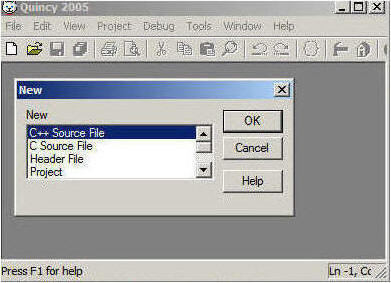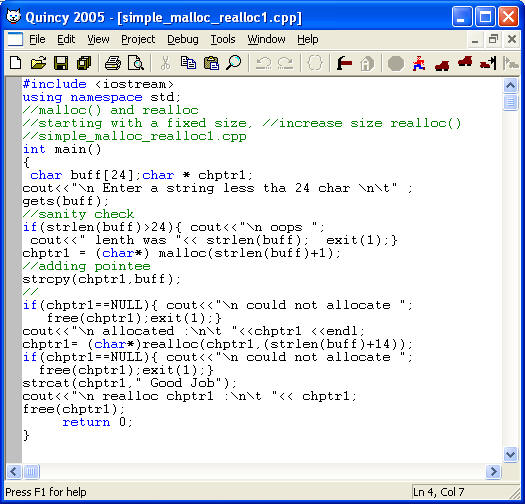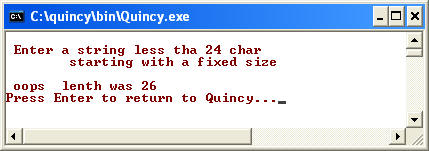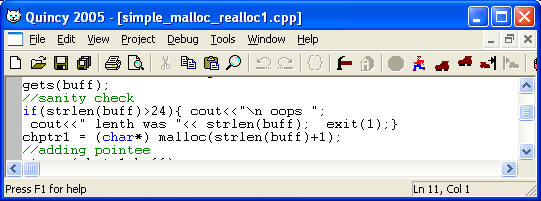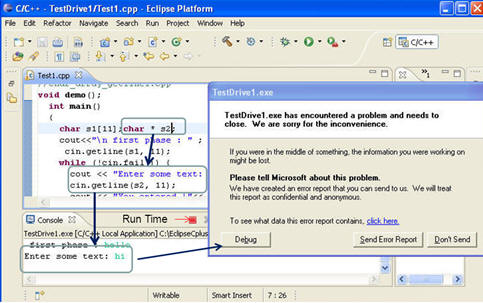Objectives : (Use Quincy 2005 or Visual Studio 2008 Express)
This example resembles msize_realloc_malloc1.htm, and in this example we added a statement to prevent the buffer-overflow before allocating data with malloc() function.
- File Name : simple_malloc_realloc1.cpp
C library provides malloc() and realloc() function, and we can assign a larger block of memory reserve to handle the user's input and on demand reallocate or resize the block to release unused space to the system.- Syntax and Uses :
char buff[24];char * chptr1;
cout<<"\n Enter a string less than 24 char \n\t" ;
gets(buff);//gets can't use an open ended pointer as a parameter
chptr1 = (char*) malloc(strlen(buff)+1);// allocates 23+1 on heap.
//sanity check,
if(strlen(buff)>24){ cout<<"\n oops ";
cout<<" lenth was "<< strlen(buff); exit(1);}- Transferring data from array to pointer: strcpy(chptr1,buff);
- Code: simple_malloc_realloc1.txt
Step: 1 Create a source file.
Step: 2 Edit and save Source file
Step: 3 Runtime Views:
a) Sanity Check : An array of static size was used to get user's input as parameter of the gets( ...) function. If users exceeded the limit, the application would be terminated.
b) Adjusting to a desired size: In this case users added an input, which was within the limit imposed by the array. The input was accepted, a pointer allocated memories from the heap, then extended the same with few more characters, by reallocating memory block.
Step 4 Brief discussion: In one of the previous example (gets_unsafe1.htm ), we noticed that the function gets(param) which uses an array as a parameter, to store character sequence (c-string) of undefined size, and can ignore the size constraints of an array.
Using Pointers: A pointer is a powerful tool, but should be used wisely, and should not be used as an open ended variable, as shown in the image below.
A pointer must be provided with the address of the data allocated by the system.
char ch1[10]; char *ptr;
ptr = &ch1[0]; // pointing at the first element of the array*/In this regard, the following definitions for "ch1" are functionally similar.
char *ch1; ch1 = (char *)malloc(100); OR char ch1[100];
char *ch1 and char ch[0] are syntactically different ways of referring the same value.In the previous example ( msize_realloc_malloc1.htm ) , we used a pointer with a predefined size, "ch1 = (char *)malloc(100);", then reallocated memories from the heap, freeing unused memories back to the system.
Function strcpy(...) : One The major advantage of C++ I/O operation rests on the use of "=" operations, where a soft-copy of one string can be passed over to another string.
string s1= " Some value" ; string s2 ; char ch1[10]; char ch2[10]; char *p1, *p2;
s2= s1; // allowed, a soft copy is created.
ch1=ch2; // not allowed
ch1[10]=ch2[10]; // compiles but ch1[10] will remain empty
p1 = (char*) malloc(strlen(ch1)+1);
p2= p2; // allowed, creates a deep copy
strcpy(p1,ch1);//allowed, array to pointer.The function strcpy(....,...), offers an easiest way to copy the reference of one array to another array or a pointer. This function copies the C-string data-source into the another array or pointer, including the null character.
Restricting oversized string: In the current example, an array of static size was reinforced with a statement block. If the users exceed the declared size, the application would terminate before allocating memories on the heap.
When users added an input which did not exceed the size-limit, the input was allocated to a memory location, so that an internal text, "Good Job", could be appended with the help of reallocation function.

